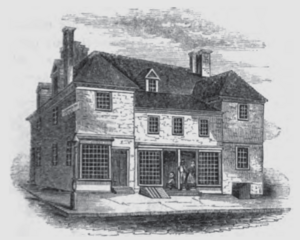Slate Roof House facts for kids
The Slate Roof House was a large, important home in Philadelphia, Pennsylvania. It stood on 2nd Street from about 1687 until 1867. A wealthy Quaker merchant named Samuel Carpenter built it. The house was on a small hill with views of the Delaware River.
It was made of brick in a style called Jacobean. This style often has two parts sticking out from the main building. The house was special because it was very big for its time. It also had a roof made of slate, which was rare in early Philadelphia.
Contents
A Home for Important People
William Penn's City Home
For two years, from 1699 to 1701, William Penn lived in the Slate Roof House. Penn was the founder of Pennsylvania. He used this house as his city home while also having a country house at Pennsbury Manor.
While living here, Penn wrote an important document. It was called the "Charter of Privileges." This document set up a fair government for Pennsylvania. It later helped inspire the United States Constitution. It also influenced how free governments work around the world.
Other Famous Residents
After Penn went back to England, James Logan lived in the house. Logan was a key leader in Pennsylvania. He helped manage the colony from 1701 to 1704.
Many other famous people stayed at the Slate Roof House over the years. These included John Adams and John Hancock. They were important members of the First Continental Congress. This group helped lead America to independence.
Baron Johann de Kalb, a hero who fought for American freedom, also stayed there. He later died in battle. Generals Charles Lee and John Forbes also passed away in the house.
The House's End
Over time, the Slate Roof House changed. In the 1700s, parts of it were used for shops. By the 1800s, the building became old and worn out. Even though historians wanted to save it, the house was torn down in 1867. A new business building took its place until 1976.
Welcome Park Today
Remembering History
In 1982, a special public space called Welcome Park was created on the site. The Independence National Historical Park manages it. The park helps people remember the history of the Slate Roof House and William Penn.
The park has a map of William Penn's original plan for Philadelphia. It is laid out on the ground using slate and marble. There is also a small bronze model of the Slate Roof House. A miniature statue of Penn stands in the center. This statue is a smaller copy of the famous one on top of Philadelphia City Hall.
Park Features and Name
The walls around the park show a timeline of William Penn's life. Welcome Park is named after Penn's ship, the Welcome. This ship brought Penn and over a hundred Quaker passengers to America in 1682.
In 2024, the National Park Service suggested changes to the park. This plan included moving the Penn statue. The ideas for renovation are currently being reviewed. The park is next to the Thomas Bond House.
See also
- Athenaeum of Philadelphia
- Letitia Street House
- Pennsbury Manor



